
A B-Side BY Armin
Zara
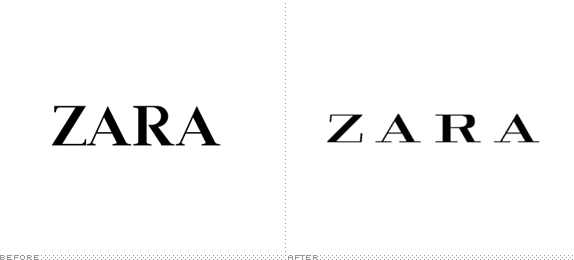
First launched in A Coruña, Galicia in Spain in 1975, Zara is a retailer of chic, semi affordable clothing for men, women, and kids with more than 1,400 stores in over 70 countries. The logo change has been spotted as early as June of 2010. Somebody please put the “A R” together a bit.
Thanks to Michael Tyznik for the tip.

DATE: Feb.04.2011 POSTED BY: Armin
POSTED BY: Armin CATEGORY: Retailers The B-Side
CATEGORY: Retailers The B-Side  COMMENTS:
COMMENTS:


Opinion BY Armin
X Marks the Shopping Spot
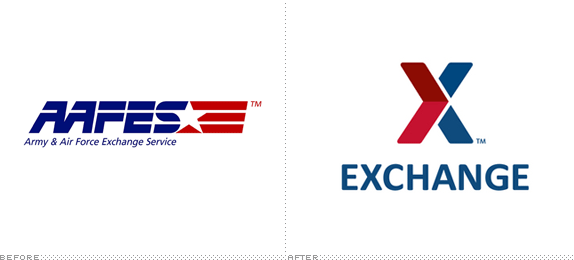
Founded in 1895, the Army and Air Force Exchange Service (AAFES) offers merchandise and services to active duty, guard and reserve members, military retirees and their families of the U.S. Army and Air Force. With more than 3,100 facilities — that include over 180 retail stores (like big Walmarts) as well as more than 1,000 fast food restaurants like Taco Bell and Burger King — in Army and Air Force bases in the U.S. and more than 30 countries, AAFES’s majority of earnings are funneled back to the Morale, Welfare and Recreation (MWR)/Services programs which, in 2009, amounted to more than $261 million. In September of last year AAFES introduced a new logo that reflected a change in name from AAFES to, simply, the Exchange. The identity and update to their retail program was done by Columbus, OH-based Chute Gerdeman.
Continue reading this entry

DATE: Jan.27.2011 POSTED BY: Armin
POSTED BY: Armin CATEGORY: Retailers
CATEGORY: Retailers  COMMENTS:
COMMENTS:


A B-Side BY Armin
Charlotte Russe
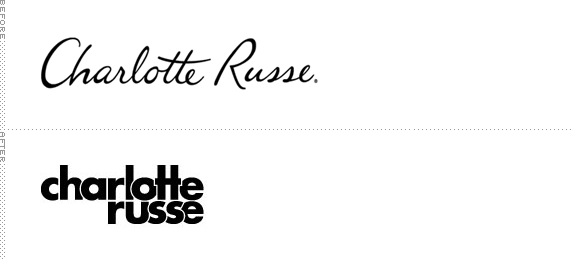
Established in 1975, Charlotte Russe is a chain of 500-plus stores located in shopping malls across America that sells groovy, trendy clothes and accessories for women in their teens to early twenties.
Thanks to Alex Poleshuk for the tip.

DATE: Jan.26.2011 POSTED BY: Armin
POSTED BY: Armin CATEGORY: Retailers The B-Side
CATEGORY: Retailers The B-Side  COMMENTS:
COMMENTS:

TAGS: lowercase, sans serif, wordmark,

A B-Side BY Armin
Alternative Apparel
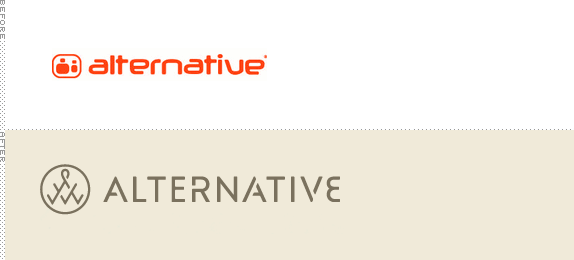
Headquartered in Norcross, GA, Alternative Apparel is a retailer and wholesaler of t-shirts, hoodies, jackets, leggings, etc., all with their “signature vintage softness.” The new logo was developed in-house.
Thanks to Andrew Thomson for the tip.

DATE: Jan.10.2011 POSTED BY: Armin
POSTED BY: Armin CATEGORY: Retailers The B-Side
CATEGORY: Retailers The B-Side  COMMENTS:
COMMENTS:


Opinion BY Christian Palino
Say it ain’t Sears
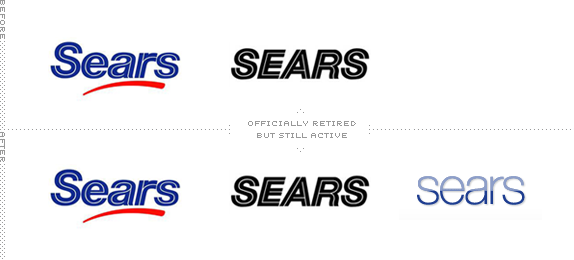
Sears, Roebuck and Co., known by its everyday name Sears, is a retailer of apparel, automotive and home products and related services in the the U.S. and Canada. Richard Sears began building his enterprise in 1886 when he took possession of a shipment of gold watches and resold them at profit. He soon after moved his newfound business to Chicago and partnered with Alvah C. Roebuck. Together they built a mail-order business that expanded from watches and jewelry to sell everything imaginable. At present, Sears is a broadline retailer with over 2,300 store locations and interestingly is the largest provider of home services in America (over 12 million service calls a year).
Continue reading this entry

DATE: Oct.29.2010 POSTED BY: Christian Palino
POSTED BY: Christian Palino CATEGORY: Retailers
CATEGORY: Retailers  COMMENTS:
COMMENTS:

TAGS: gradient, sans serif, sears,

Opinion BY Armin
FAO Schwarz’s New Hire: Wit
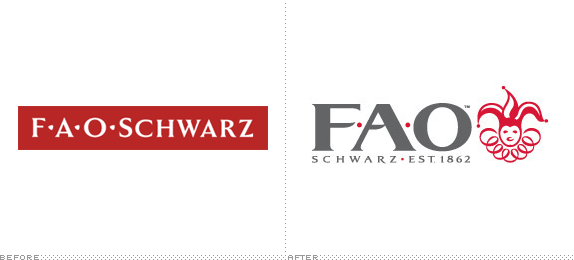
Established in 1862 in Baltimore, Maryland by Frederick August Otto Schwarz, FAO Schwarz is today the mecca of toy stores with a flagship store in New York as famous as the Statue of Liberty, except with more foot traffic, more profitable, and the dream for kids and adults to play “Chopsticks” on the giant piano made famous by Tom Hanks in Big, released in 1988, two years after FAO moved to its famed location. In 2009, Toys “R” Us acquired FAO with the intent of keeping the same magical formula that has made it so attractive over the years. If you ever went to FAO as a kid you know that feeling. It is quite incomparable. As an adult it simply holds nostalgia, which dissipates as soon as you enter the overcrowded, visually and aurally saturated store. In any event, FAO has redesigned its identity and packaging of house products to welcome the 2010 holiday shopping season, and has introduced a new character, Wit.
Continue reading this entry

DATE: Oct.19.2010 POSTED BY: Armin
POSTED BY: Armin CATEGORY: Retailers
CATEGORY: Retailers  COMMENTS:
COMMENTS:

TAGS: fao schwarz, icon, new york, serif,

Opinion BY Armin
Fits like a G(love)
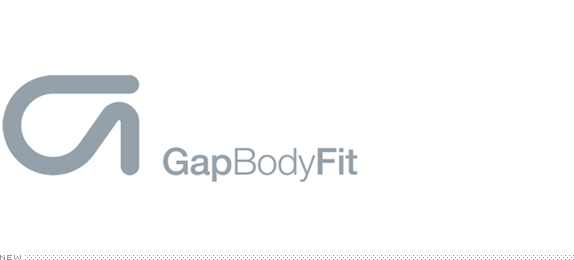
Just when you thought you had heard the last of Gap, we bring you… more Gap! Except that this is a little more uplifting than last week’s meltdown. If we take it from the top, boiling it down to product lines, there is Gap. Then there is Gap Women. In there is GapBody. Now, recently launched, is the GapBody Fit collection, a new range of women’s premium athletic clothing. Battling for consideration against larger branding and design firms the small, San Francisco-based Manual won the job. (You might remember them from the Slice identity.)
Continue reading this entry

DATE: Oct.14.2010 POSTED BY: Armin
POSTED BY: Armin CATEGORY: Retailers
CATEGORY: Retailers  COMMENTS:
COMMENTS:

TAGS: gap, helvetica, manual creative, sans serif,

Follow-Up BY Armin
Follow-up: Gap, Undo

It’s a double Command-Z for Gap as Marka Hansen President of Gap Brand North America announced yesterday that not only was it canceling its crowdsourcing venture but that it was reverting back to its old logo. As satisfying as it may be to see Gap acknowledge this blunder I was more excited by the prospect of their crowdsourcing, just to see how bad it would get before it got any better. Score one for the angry mob. I can’t imagine what it will be like for Gap when they try this again, if ever — it might end up being the longest lasting logo in history.
PS. In other news, yes, I’m aware of the MySpace logo redesign. Trying to get actual images from them, rather than the distorted version that’s been circulating.

DATE: Oct.12.2010 POSTED BY: Armin
POSTED BY: Armin CATEGORY: Retailers
CATEGORY: Retailers  COMMENTS:
COMMENTS:


Opinion BY Armin
Follow-up: Gapgate

I never expected the Gap logo to be such a lightning bolt of attention. Yes, it’s bad and yes it’s a popular brand, but to have captured the attention of the whole internet, even reaching meme levels wasn’t something I ever expected the grilled chicken of retail brands to achieve. Despite not being the first blog to jump on the news, our traffic tripled to over 115,000 pageviews on Wednesday and doubled to 84,000 yesterday. This is not to brag about traffic, but a factual representation of the mainstream interest this redesign has gotten. The aftermath of the new logo’s launch has been both hilarious and painful. Following are the most interesting developments of the last 48 hours.
Continue reading this entry

DATE: Oct.08.2010 POSTED BY: Armin
POSTED BY: Armin CATEGORY: Retailers
CATEGORY: Retailers  COMMENTS:
COMMENTS:


Opinion BY Armin
Belk Flourishes
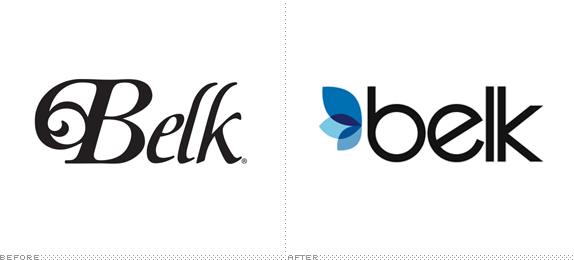
Originally established as the New York Racket in 1888 by William Henry Belk Monroe, North Carolina, today Belk is a department store with over 300 locations across sixteen southern U.S. states. As a privately held business, Belk has also stayed in the family with three Belk brothers currently occupying the CEO, CMO, and COO positions. This week, Belk announced a major redesign of their stores and everything within and around them, including, of course, the logo, replacing a 43-year-old logo. The identity has been designed by Columbus, OH-based Ologie.
Continue reading this entry

DATE: Oct.07.2010 POSTED BY: Armin
POSTED BY: Armin CATEGORY: Retailers
CATEGORY: Retailers  COMMENTS:
COMMENTS:

TAGS: blue, icon, ologie, sans serif,





























